16 Best Indoor Succulents
Are you looking for a new plant to improve your indoor succulents collection? Or do you want something easy to grow but with high visual impact? The following list is perfect for you!
Currently, succulents are a kind of big deal and trendy decoration for modern homes. But, even though succulents aren’t high-maintenance plants, you need to follow a few simple rules.
The worst thing you can do for your succulents is overwater them! But, I will walk you through the list of indoor succulents and provide you with the basic care rules for each plant.
Here is the list of the most amazing succulents that you can grow indoors!
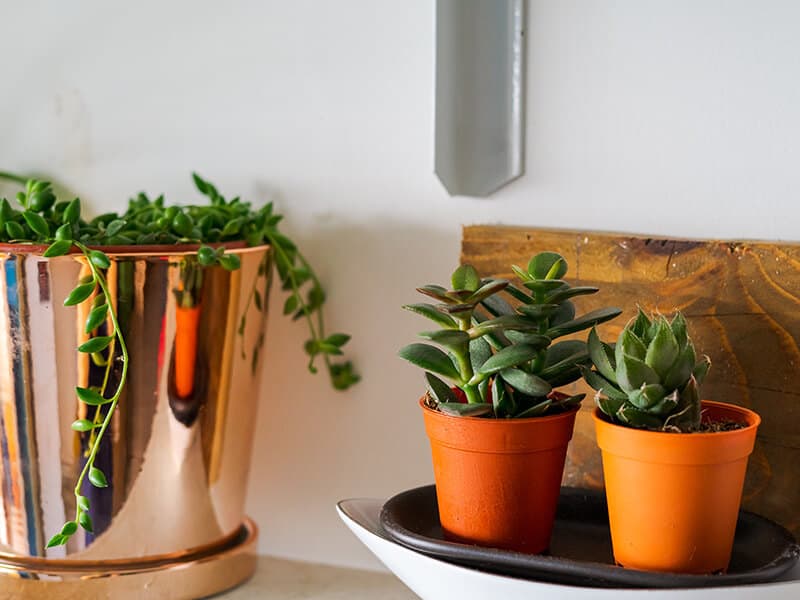
#1 Burro’s Tail
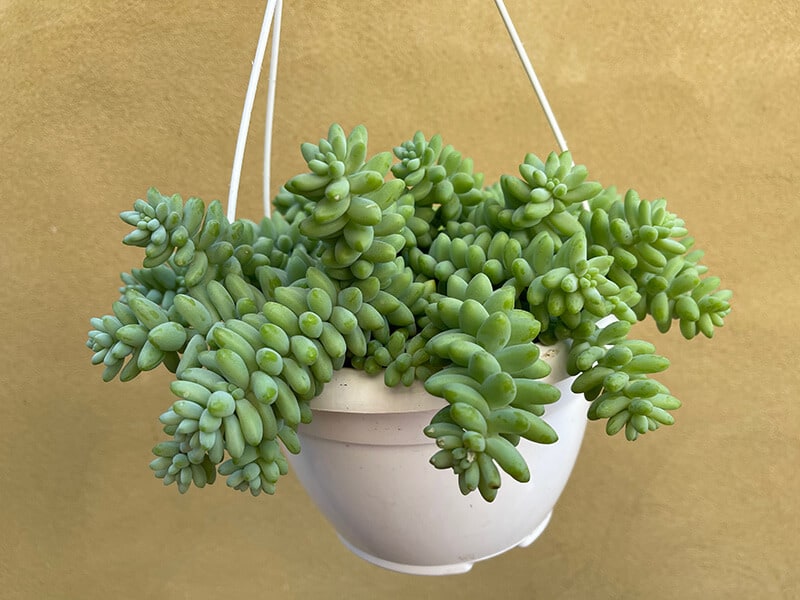
Sedum morganianum is an attractive and unusual plant, well-known under the names Burro’s Tail or Donkey’s Tail. It’s a trailing succulent that looks best when you keep it in a hanging basket. The greenish leaves fall from the basket and create a beautiful and unusual display!
The plant is relatively easy to grow, as long as you keep it from the draft. Burro’s Tail prefers full sun exposure but can tolerate light shade. The plant is sensitive to cold temperatures. But if you keep it indoors, you don’t have to worry about that.
Moreover, slightly cooler temperatures in winter may encourage Burro’s Tail to bloom in the spring! Also, Burro’s Tail is one of the easiest plants to propagate by leaf or stem cuttings.
Remember, the plant doesn’t need a lot of water. Only water the plant once a month to prevent roots rotting!
#2 Crown of Thorns
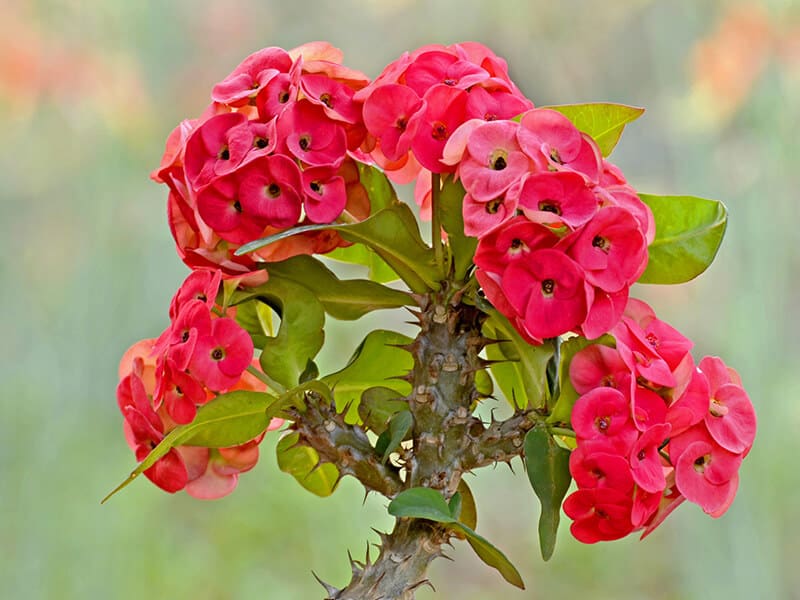
If you are looking for a succulent that can bloom almost year-round, check the Crown of Thorns. The botanical name is Euphorbia milii, and the plant is great for outdoor and indoor placement as well.
It features green foliage with interesting green flowers with bright orange, red, yellow and white bracts. When you grow it outdoors, Euphorbia milii can grow as a woody shrub and can reach three feet in height. Indoors, it remains compact and gets the ideal shape for a houseplant.
The Crown of Thorns enjoys standard indoor temperatures and doesn’t like the dry air. It is a slow-growing plant that is toxic to pets.
The Crown of Thorns requires slightly acidic soil, full sun and infrequent watering. You can also use a balanced fertilizer in the growing season to induce the blooming.
#3 Aloe Vera

Surprisingly, Aloe vera prefers indoor growing conditions. The plant is such a versatile houseplant. It can be a beautiful decoration, but also a practical plant. You can make your own gel for cosmetic purposes, use the aloe vera flesh for hair and skin mask and more.
Luckily, Aloe vera isn’t difficult to grow. Pick a bright windowsill where the plant will receive filtered light.
The plant stores water in foliage, so it doesn’t need a lot of water. Add a thin layer of compost around the base of the plant, and let it dry completely between watering. Ideally, the soil needs to be well-draining to prevent rotting.
You can also use a weak fertilizer in spring and summer to boost growth. Aloe vera is a slow grower. It will need repotting every three years.
You can see this video to know more:
#4 Hens and Chicks
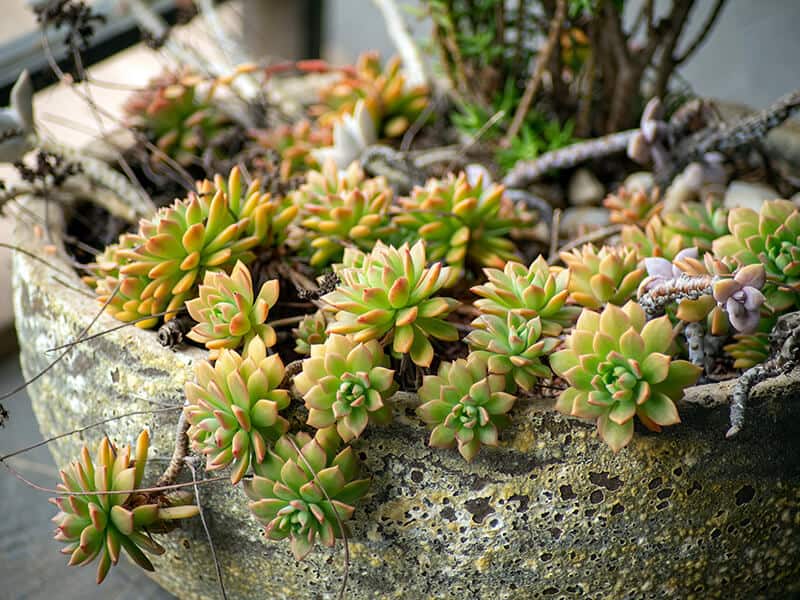
Sempervivum tectorum or Hens and Chicks succulent thrives in temperatures between 65 and 75 degrees. Therefore, the plant enjoys common indoor temperatures for the most part of the year.
Hens and Chicks plants need a lot of light. The ideal location for this succulent is a bright, south or east-facing window.
It is a compact plant, which rarely grows over four or five inches.
Hens and Chicks succulents aren’t picky about the soil quality.
It can survive in poor quality soil, and it doesn’t need fertilizer. But, you can use mild, balanced fertilizer in spring and summer to make the foliage more vibrant.
#5 Zebra Cactus
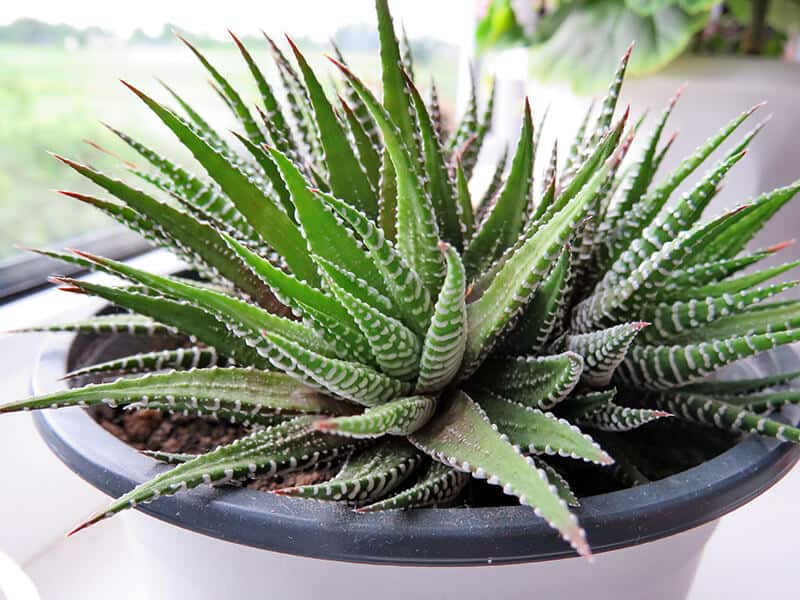
Haworthia fasciata or Zebra cactus prefer average home temperatures between 65 and 75 degrees Fahrenheit. The plant enjoys a lot of bright sunlight but can grow well when exposed to filtered light as well.
General care is very simple. You only need to water the plant occasionally, every two or three weeks. You can check if the topsoil level is dry before watering the plant.
But, if the plant is exposed to too much light, you might need to water more frequently. The signs of thirsty plants are curling leaves. Oppositely, if the plant foliage turns yellow, you should stop watering the plant.
Also, if your Haworthia isn’t exposed to too much light, you’ll need to water it rarely.
Haworthia is also one of the most compact indoor succulents. It remains about two inches tall and about the same width.
The plant doesn’t mind dry indoor air. In fact, it will remain good-looking in all humidity conditions.
#6 Pencil Cactus
Here is a plant with a beautiful visual impact – Euphorbia tirucalli or Pencil cactus.
When you grow it indoors, the plant needs the brightest location possible. A south-facing window will provide the plant with a lot of sunlight, so it can thrive and grow to its full potential.
If you get the lighting conditions right, the rest is simple. Euphorbia tirucalli needs watering every two or three weeks when the soil dries out. In winter, reduce the watering, and the plant generally needs little winter care.
When your Pencil plant drops the stems, it is a sign that you’ve overwatered it. Plants that are exposed to low lighting need less water and are generally more prone to problems and rotting.
In ideal conditions Euphorbia tirucalli grows up to six feet! The plant is a fast grower. Sometimes, it can grow up to 20 inches per season!
#7 Christmas Cactus
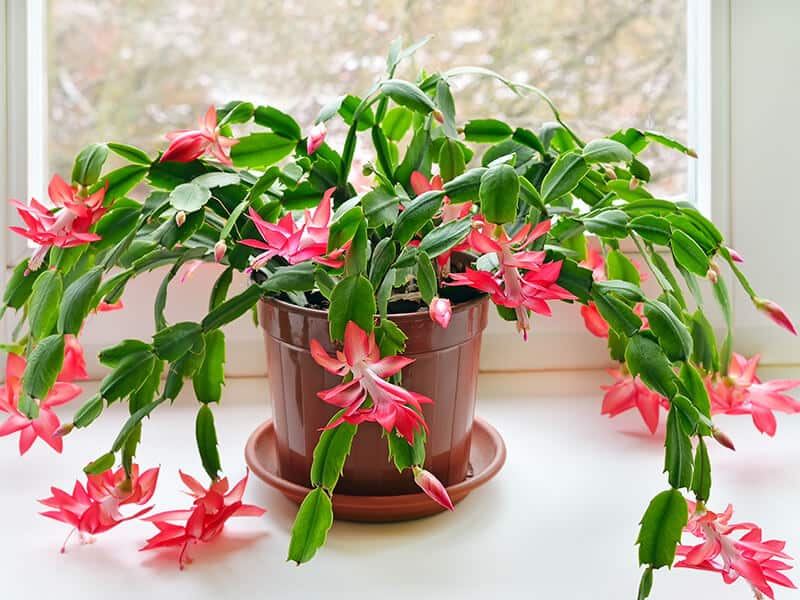
Christmas Cactus might be a bit tricky to grow or maintain the most beautiful flowers. The optimal temperature for Schlumbergera x buckleyi is around 65 degrees Fahrenheit. Therefore, a cool hallway might be a good choice for the plant.
During the blooming season, the plant needs consistent moisture and higher humidity. You can help it develop flowers with regular misting.
Christmas cactus also needs moderate light.
Outside the blooming season, water your Christmas cactus every two or three weeks.
Ideally, the plant should be exposed to direct sunlight in the morning.
The trick to having the most delightful flowers around the Christmas season is to use a high-potassium fertilizer. Amend the soil with the fertilizer once the first buds form.
#8 Jade Plant
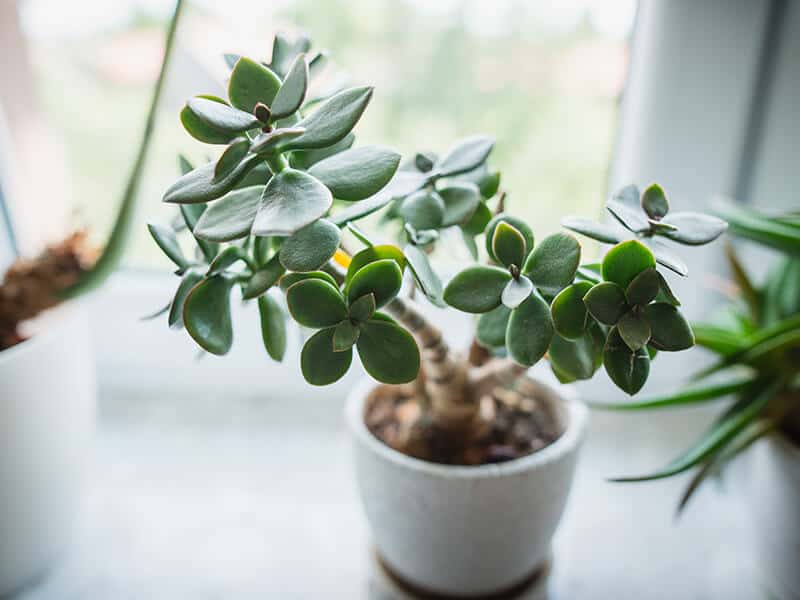
Crassula ovata is a cold-sensitive plant. It is why the plant is easy to grow indoors. During the warmest parts of the year, you can bring the plant outdoors, but don’t forget to bring the plant back when the temperatures drop below 65 degrees Fahrenheit.
An ideal indoor location for a Jade plant is a bright spot, such as a south-facing windowsill. But, the Jade plant can also grow in darker conditions.
The ideal soil for Crassula ovata is clay or loamy, with a neutral pH value and excellent drainage. The plant is grown for attractive foliage and low-maintenance features.
Crassula ovata is believed to bring money and prosperity to the home where you grow it. So, it is also an excellent present for your loved ones! Because of the low maintenance nature, Crassula ovata is a beginner-friendly plant.
#9 Flaming Katy
Flaming Katy or Kalanchoe blossfeldiana is a common houseplant, which might be tricky to keep alive in all indoor conditions. But, with a few tips, you can grow the most beautiful Flaming Katies!
Water the plant only when the soil seems dry. But, avoid wetting the foliage, as it can make them sick.
Flaming Katy develops beautiful little flowers, and deadheading is an important routine step. Also, if you notice any dead stems or infected foliage remove them instantly.
Avoid exposing the plant to low temperatures, as cold can kill the plant quickly.
#10 Panda Plant
Kalanchoe tomentosa or Panda plant is a wonderful indoor succulent with velvety foliage and easy-going nature. The plant is drought-tolerant and doesn’t need too much water.
When the top layer of soil is dry, water the plant.
Panda plant is sensitive to cold temperatures but doesn’t like hot temperatures as well. The ideal temperature range for the plant is between 60 and 75 degrees Fahrenheit.
To boost the growth, use fertilizer every month during the growing season. Don’t forget to dilute fertilizer, to prevent foliage burns.
Panda plant generally grows slowly, so it doesn’t need frequent repotting.
#11 String of Pearls
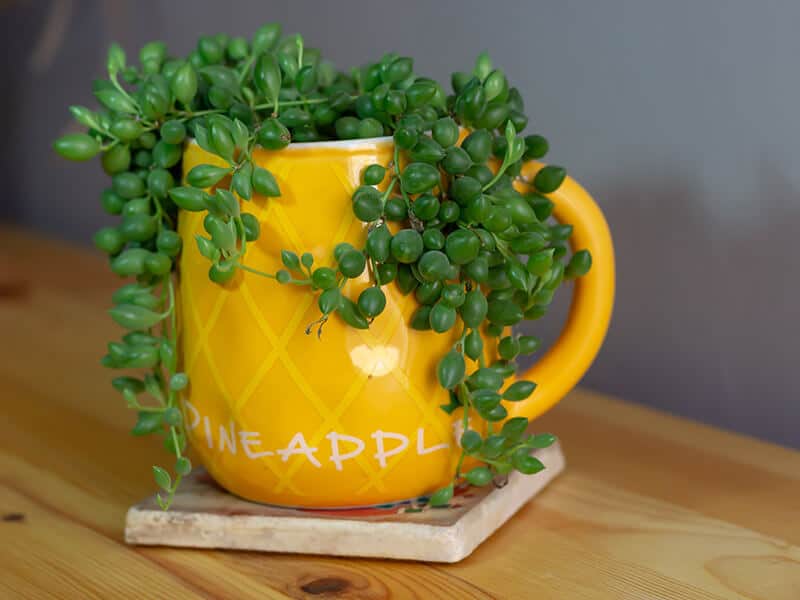
A string of Pearls or Senecio rowleyanus prefers slightly higher temperatures in the growing seasons than most succulents. The perfect range is between 70 and 80 degrees Fahrenheit.
During winter, keep the plant at a temperature between 55 and 60 degrees Fahrenheit for optimal growth.
The String of Pearls is also sensitive to draft or sources of warmth and cold. Therefore, don’t keep the plant near the AC unit or an open window.
You can use a potting mix for cactus plants and water the plant every two or three weeks. A String of Pearls is drought-tolerant and sensitive to overwatering. It looks the best in a hanging basket and can instantly transform every indoor space.
#12 Snake Plant

Dracaena trifasciata or popular Snake plant is a common houseplant because of the low-maintenance and attractive foliage.
Snake plant is tolerant to a variety of lighting conditions, but it thrives in bright, indirect light. The plan needs all-purpose fertilizer during the growing season and little water. During winter, reduce the watering as the plant can rot if exposed to too much moisture.
Also, try to keep the foliage dry when watering. Wet leaves can develop infections and kill the plant. Also, the best thing about the Snake plant is that it grows best when you forget about it!
#13 Ponytail Palm
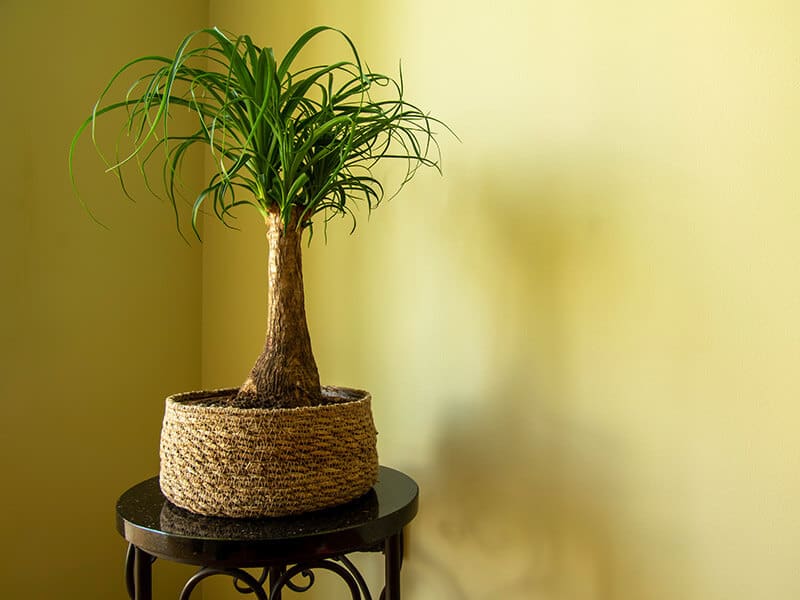
Beaucarnea recurvata or Ponytail palm is an interesting choice for indoor succulents. It is a large succulent that develops lovely foliage, which gives a tropical vibe to your indoor space.
Ponytail palm is tolerable to dry conditions, and it can thrive in most homes. It also requires dry soil, so resist the urge to water the plant. Before repotting, don’t water the plant for a while, so the roots can bond.
You can use fertilizer two times per year to keep the plant healthy and thriving.
Ponytail palm is a forgiving plant and a beginner-friendly one with a beautiful appearance. Half of the time, the Ponytail plant needs bright, indirect light. In the other half, the plant can survive in darker conditions.
You can see this video to know more:
#14 Lithops
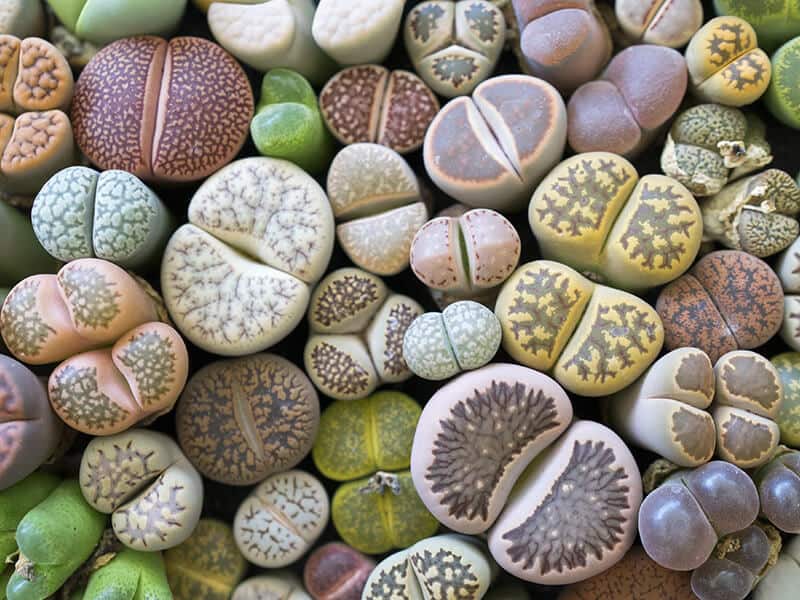
Lithops or Living stone succulents look like actual stones! But, they are plants with simple care! These unusual-looking plants grow exposed to harsh sunlight in their native habitat. But, indoors, Lithops need about four to five hours of bright light.
Afternoon shade is just fine, so you can pick an east window to keep your little Lithops.
In late summer, or early fall, Lithops bloom and provide a spectacular display with lovely yellow or white flowers.
You only need to water these plants occasionally during winter. In the growing season, water Lithops twice a month.
#15 African Milk Tree
Euphorbia trigona is a scientific name of the plant you might recognize as African Milk Tree. The plant needs soil with excellent drainage and occasional feeding with balanced succulent fertilizer.
Amend soil with the fertilizer once a month in spring and summer. With proper indoor care the African Milk Tree gets between two and four feet tall!
Also, the plant needs watering every two or three weeks in the growing season. But, in winter, don’t use fertilizer and reduce watering to a minimum.
African Milk Tree prefers dryer air. Therefore, never put the plant in the bathroom or kitchen.
You can see this video to know more:
#16 String of Bananas
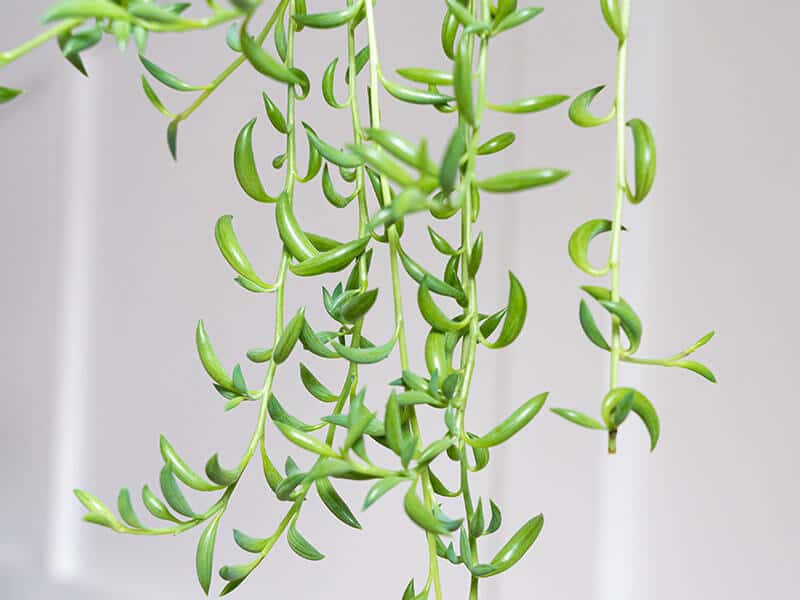
Curio radicans or String of Bananas is a trailing succulent that needs a lot of light to thrive! If you keep the plant in the dark, your String of Bananas won’t grow at all.
Water the plant every two or three weeks to keep the plant moisturized but not soaked.
The String of Bananas doesn’t need fertilizer. You can add a layer of compost in spring to boost the nutrient value in the soil and support healthy plant growth. Liquid kelp or low fertilizer will also be suitable.
Choose Plant Decoration: Pick Indoor Succulents
Succulents are a great plant to grow indoors. They are rarely affected by pests and diseases, especially if you follow the basic rules for growing succulents indoors.
These plants store water in their foliage, so they don’t need a lot of water. The sunlight requirements vary from plant to plant, but most indoor succulents prefer a lot of sunlight.
I like the Panda plant and the Pencil cactus the most. What about you? Which indoor succulents will you choose for your collection?
If you enjoyed the article, give it a thumbs up!

